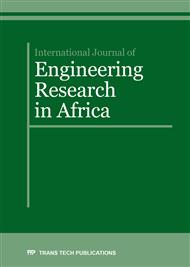[1]
Serge Abrate, Impact on laminated Composites: Recent Advances. Appl Mech Rev, 47 (1994) 517–44.
Google Scholar
[2]
Andreas P. Christoforou, Ahmet S. Yigit, Scaling of low-velocity impact response in composite structures, journal of Composite Structures, 91 (2009) 358–365.
DOI: 10.1016/j.compstruct.2009.06.002
Google Scholar
[3]
Ik Hyeon Choi, Cheol Ho Lim, Low-velocity impact analysis of composite laminates using linearized contact law, journal of Composite Structures, 66 (2004) 125–132.
DOI: 10.1016/j.compstruct.2004.04.030
Google Scholar
[4]
D. Liu, L.E. Malvern, Matrix cracking in impacted glass/epoxy plates, Journal of Composite Materials, 21 (1987) 594–609.
DOI: 10.1177/002199838702100701
Google Scholar
[5]
G.A.O. Davies, D. Hutchings, G. Zhou, Impact damage and residual strengths of woven fabric glass/polyester laminates, Composites A-27 (12) (1996) 1147–1156.
DOI: 10.1016/1359-835x(96)00083-8
Google Scholar
[6]
Serge Abrate, Modeling of impacts on composite structures, journal of Composite Structures, 51 (2001) 129-138.
DOI: 10.1016/s0263-8223(00)00138-0
Google Scholar
[7]
Sun CT, Chen JK, On the impact of initially stressed composite laminates, Journal of Composite Materials, 19 (1985) 490–504.
DOI: 10.1177/002199838501900601
Google Scholar
[8]
K. Azouaoui, N. Ouali, Y. Ouroua, A. Mesbah, T. Boukharouba, Damage characterisation of glass/polyester composite plates subjected to low-energy impact fatigue, Journal of Sound and Vibration, 308 (2007) 504–513 K.
DOI: 10.1016/j.jsv.2007.04.014
Google Scholar
[9]
Nawras H . Mostafa et al, Effect of fabric biaxial prestress on the fatigue of woven E-glass/polyester, journal of composites Materials and Design, 92 (2016) 579–589.
DOI: 10.1016/j.matdes.2015.12.109
Google Scholar
[10]
A. Esnaola et al, Effect of fibre volume fraction on energy absorption capabilities of E-glass/polyester automotive crash structures, Composites Part B 85(2016) 1-7.
DOI: 10.1016/j.compositesb.2015.09.007
Google Scholar
[11]
A. Esnaola et al, Quasi-static crush energy absorption capability of E-glass/polyester and hybrid E-glass-Basalt/polyester composite structures, Journal of Materials and Design, 76 (2015) 18–25.
DOI: 10.1016/j.matdes.2015.03.044
Google Scholar
[12]
Patel SR, Case SW, Durability of a graphite/epoxy woven composite under combined hygrothermal conditions, International Journal of Fatigue, 22 (2000) 809–20.
DOI: 10.1016/s0142-1123(00)00041-4
Google Scholar
[13]
Amal A.M. Badawy, Impact behavior of glass fibers reinforced composite laminates at different temperatures, Ain Shams Engineering Journal (2012) 3, 105–111.
DOI: 10.1016/j.asej.2012.01.001
Google Scholar
[14]
K. S. Sai Ramand P. K. Sinha, Hygrothermal effects on the free vibration of laminated composite plates, Journal of Sound and Vibration, vol. 158(1), (1992), pp.133-148.
DOI: 10.1016/0022-460x(92)90669-o
Google Scholar
[15]
R. Selzer and K. Friedrich, Mechanical properties and failure behavior of carbon fiber-reinforced polymer composite under the influence of moisture, Composite 28A (1997), 595-604.
DOI: 10.1016/s1359-835x(96)00154-6
Google Scholar
[16]
Whitney, J.M. and Ashton, J. E, Effect of Environment on the Elastic Response of Layered Composite Plates, AIAA Journal, 9 (1971) 1708–1713.
DOI: 10.2514/3.49976
Google Scholar
[17]
Reddy JN, Free vibration of anti-symmetric angle ply laminated plates including transverse shear deformation theory by finite element method, Journal of Sound and Vibration; 66(4), (1979) 565–76.
DOI: 10.1016/0022-460x(79)90700-4
Google Scholar
[18]
H. S. Panda, S. K. Sahu, and P. K. Parhi, Hygrothermal effects on free vibration of delaminated woven fibre composite plates – Numerical and Experimental results, Composite Structures, vol. 96, pp.502-513, (2013).
DOI: 10.1016/j.compstruct.2012.08.057
Google Scholar
[19]
Rao VVS, Sinha PK, Dynamic response of multi directional composites in hygrothermal environments, Journal of Composite Structure, 64 (2004) 329–38.
Google Scholar
[20]
W. Ostachowicz and M. Krawczuk, Dynamic analysis of delaminated composite beam, Machine Vibration 3 (1994) 107116.
Google Scholar
[21]
T. Roy and D. Chakraborty, Delamination in FRP laminates with holes under transverse impact, journal of Materials and Design, 29 (2008) 124-132.
DOI: 10.1016/j.matdes.2006.11.016
Google Scholar
[22]
Boukhoulda F. B & all, Aging-impact coupling based analysis upon glass/polyester composite material in hygrothermal, Journal of materials and design, Vol. 32 (2011), pp.4080-4087.
DOI: 10.1016/j.matdes.2011.03.009
Google Scholar
[23]
B. J. Schwartz and M. H. Richardson, Experimental modal analysis, CSI Reliability week, Orlando, FL, Octobre (1999).
Google Scholar
[24]
Ch. Lalanne: Vibrations et chocs mécaniques. Tome 2, Chocs mécaniques. Hermès, Paris, (1999).
Google Scholar


